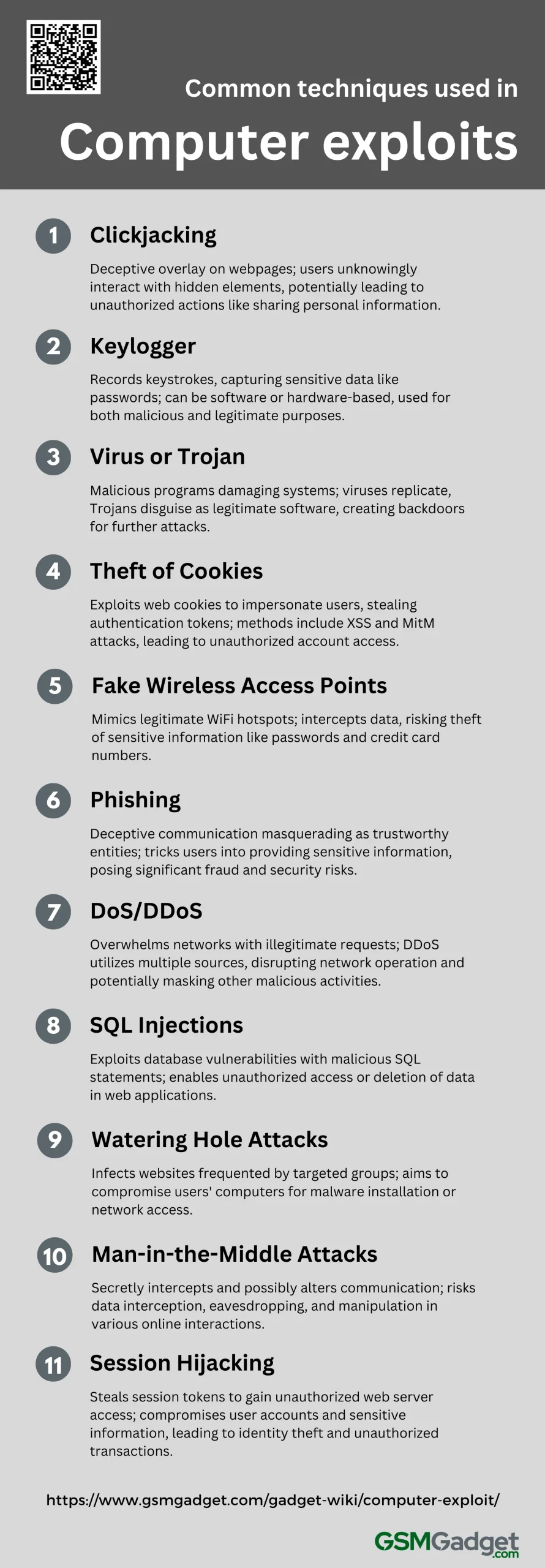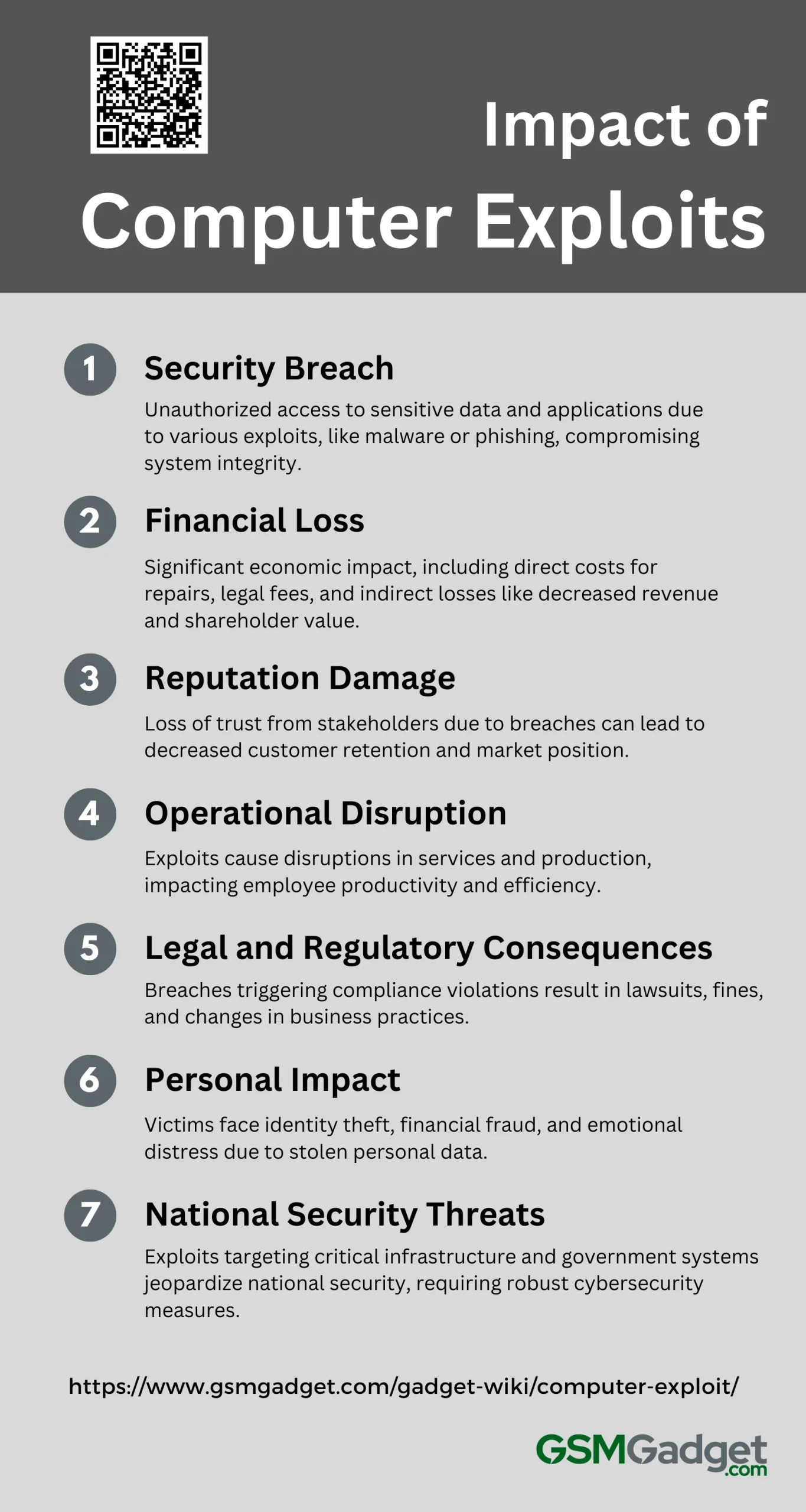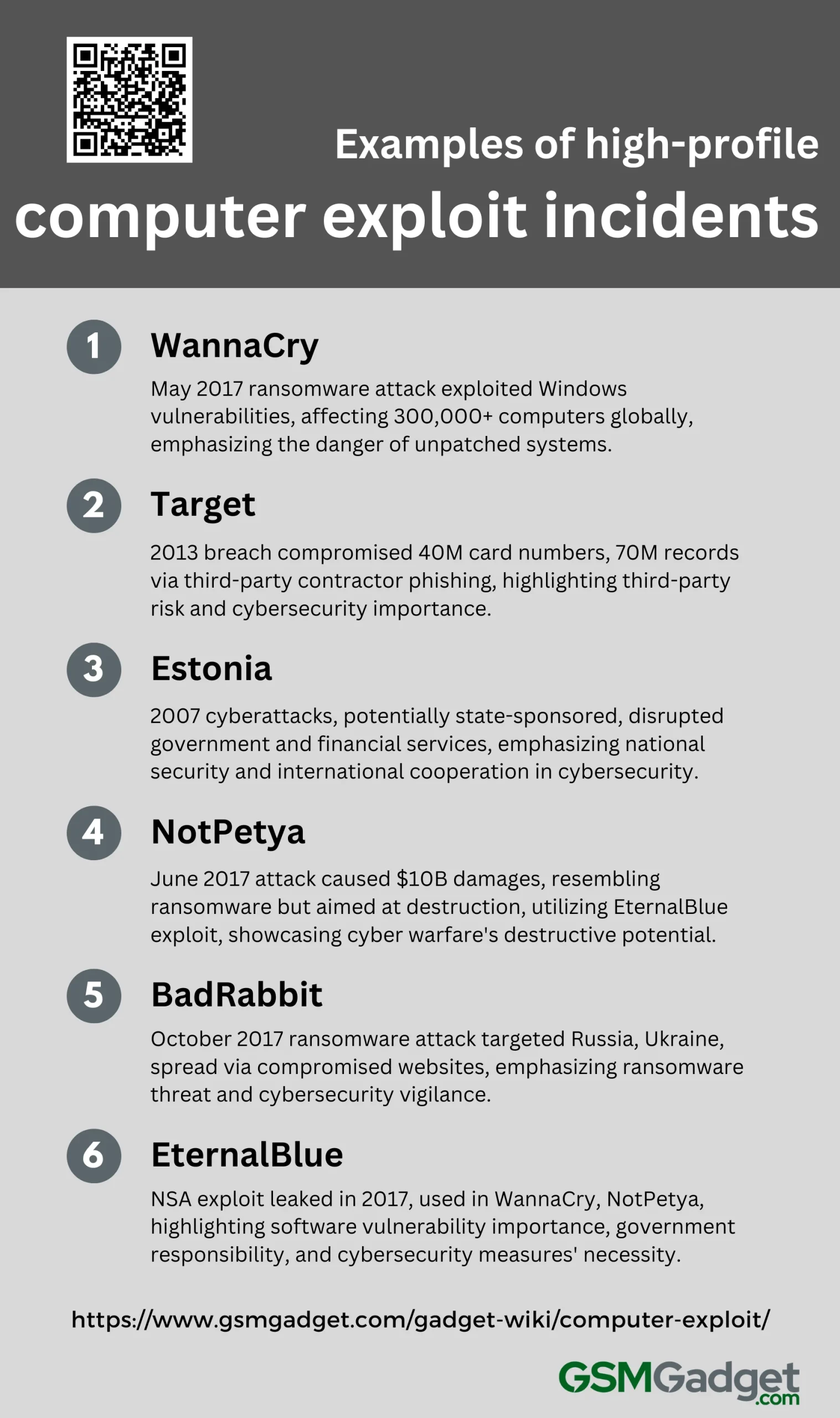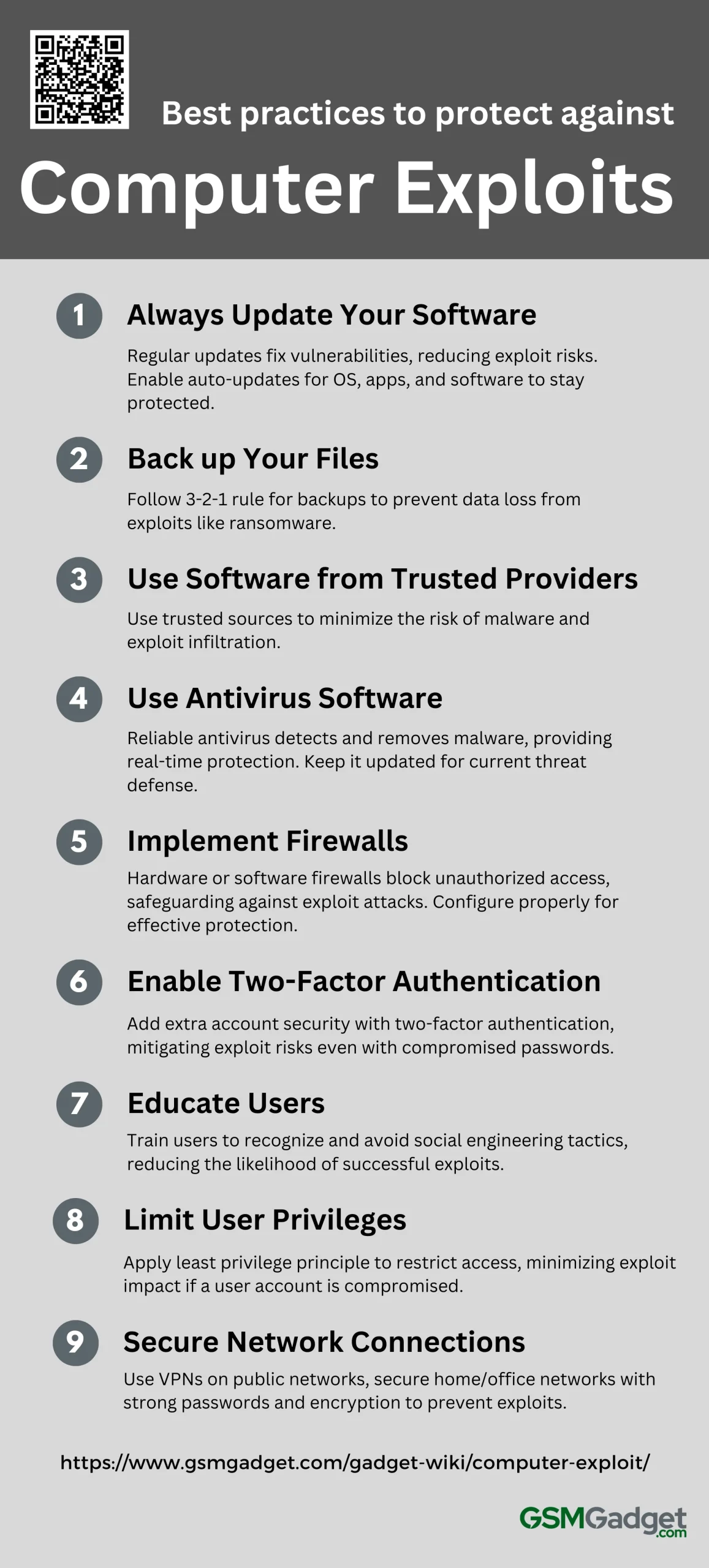A computer exploit is a piece of software, a set of commands, or a sequence of actions utilized to take advantage of a bug, glitch, or vulnerability in computer software or systems. This exploitation allows attackers to perform unauthorized actions within the system, such as gaining control, escalating privileges, or launching a denial-of-service attack. Exploits can be classified based on their method of delivery or the type of vulnerability they target, including known vulnerabilities (where patches may exist but have not been applied) and zero-day vulnerabilities (previously unknown and thus unpatched). The primary goal of an exploit is often malicious, aiming to compromise system integrity, confidentiality, or availability for various purposes, including theft, fraud, or sabotage
Types of Computer Exploits
Understanding the various types of computer exploits is crucial for both professionals and casual users alike. Exploits are malicious tools or methods that take advantage of vulnerabilities within systems to execute unauthorized actions. These vulnerabilities can be found in software, hardware, and network configurations. The classification of exploits includes several categories such as remote, local, and client-based, each with unique characteristics and methods of attack. This knowledge not only aids in recognizing potential threats but also in implementing effective security measures to protect sensitive data and systems.
- Hardware Exploits (DND)
- Firmware Exploits
- Software Exploits
- Network Exploits
- Personnel Exploits
- Organizational Exploits
- Buffer Overflow Exploits
- Code Injection Exploits
- Cross-Site Scripting (XSS)
- Cross-Site Request Forgery (CSRF)
- Privilege Escalation
- Phishing and Spear-Phishing Attacks
- Web application exploits
- Social engineering exploits
Common techniques used in computer exploits

1. Clickjacking
Clickjacking, also known as a “UI redress attack,” involves tricking a user into clicking on something different from what the user perceives. This technique exploits vulnerabilities related to HTML iframes, allowing an attacker to overlay a transparent or invisible layer over a legitimate webpage. Users believe they are interacting with the original page, but their actions are actually directed towards the hidden layer, potentially leading to unauthorized actions such as liking a social media post, sharing personal information, or even initiating financial transactions without their consent.
2. Keylogger
Keyloggers are a type of surveillance technology that records every keystroke made on a computer. This data can include sensitive information such as passwords, credit card details, and personal messages. Keyloggers can be software-based, installed via malicious downloads or phishing emails, or hardware-based, requiring physical access to the device. They are used for malicious purposes like identity theft and fraud but can also be employed for legitimate monitoring by employers or parents.
3. Virus or Trojan
Viruses and Trojans are malicious programs designed to damage, disrupt, or gain unauthorized access to computer systems. A virus can replicate itself and spread to other computers, while a Trojan disguises itself as legitimate software to trick users into installing it. Once activated, Trojans can delete, block, modify, or copy data and disrupt the performance of computers or computer networks. They often create backdoors in security to allow further attacks or theft of data.
4. Theft of Cookies
Cookie theft involves hijacking a user’s web cookies to gain unauthorized access to their personal accounts on various websites. Cookies store user data, including authentication tokens that can be exploited to impersonate the user. Attackers can use techniques like cross-site scripting (XSS) or man-in-the-middle (MitM) attacks to steal cookies. This type of attack can lead to unauthorized access to private accounts, personal data theft, and security breaches in online services.
5. Fake Wireless Access Points (W.A.P)
Fake wireless access points (WAPs), often called “Evil Twins,” mimic legitimate WiFi hotspots to deceive users into connecting to them. Once connected, attackers can monitor and intercept data transmitted over the network, including passwords, credit card numbers, and other sensitive information. This technique is commonly used in public places to exploit the connectivity needs of users, leading to significant security risks such as data theft and unauthorized access.
6. Phishing
Phishing involves tricking individuals into providing sensitive information such as usernames, passwords, and credit card details by masquerading as a trustworthy entity in electronic communications. Typically carried out through email spoofing or instant messaging, it directs users to enter personal information at a fake website whose look and feel are almost identical to the legitimate one. Phishing is one of the most common methods of online fraud and poses significant risks to personal and organizational security.
7. Denial of Service or Distributed Denial of Service (DoS/DDoS)
Denial of Service (DoS) and Distributed Denial of Service (DDoS) attacks aim to make a machine or network resource unavailable to its intended users by overwhelming it with a flood of illegitimate requests. DDoS attacks utilize multiple compromised computer systems as sources of attack traffic. These attacks can severely disrupt the operation of networks and can be used as a smokescreen for other malicious activities.
8. SQL Injections
SQL injection is a code injection technique that exploits a security vulnerability occurring in the database layer of an application. The vulnerability is present when user inputs are either incorrectly filtered for string literal escape characters embedded in SQL statements or user input is not strongly typed and unexpectedly executed. SQL injection allows attackers to execute malicious SQL statements that control a web application’s database server, leading to unauthorized data access or deletion.
9. Watering Hole Attacks
In a watering hole attack, the attacker seeks to compromise a specific group of users by infecting websites that members of the group are known to visit. The goal is to infect a targeted user’s computer and gain access to the network at the target’s workplace. This attack can result in the installation of malware, data theft, or gaining unauthorized access to networked systems.
10. Man-in-the-Middle (MitM) Attacks
Man-in-the-Middle (MitM) attacks involve an attacker secretly relaying and possibly altering the communication between two parties who believe they are directly communicating with each other. This can happen in any form of online communication, such as email, social media, and online banking. MitM attacks can lead to the interception of personal information, eavesdropping, and data manipulation, posing significant risks to data confidentiality and integrity.
11. Session Hijacking
Session hijacking, also known as session token hijacking, exploits the web session control mechanism, which is normally managed by a session token that exists in the URL or web page’s cookie. By stealing these tokens, attackers can gain unauthorized access to the web server. This type of attack can compromise user accounts, personal data, and sensitive business information, leading to a range of security issues including identity theft and unauthorized transactions.
Impact of Computer Exploits

1. Security Breach
Computer exploits often lead to security breaches, where unauthorized access to a system’s data and applications occurs. This unauthorized access can result in the exposure of sensitive information, including personal data, intellectual property, and trade secrets. The breach can stem from various types of exploits, such as malware, ransomware, or phishing attacks, which capitalize on vulnerabilities within the system. The consequences of these breaches are not only immediate but can also have long-lasting effects on the integrity and security of the affected systems.
2. Financial Loss
The financial impact of computer exploits can be devastating. Organizations may incur direct costs such as system repair, security updates, and legal fees. Additionally, indirect costs like lost revenue due to business interruption can significantly affect the bottom line. For instance, the global average cost of a data breach has reached millions, reflecting not only immediate response expenses but also long-term financial impacts such as customer compensation and decreased shareholder value.
3. Reputation Damage
Reputation damage is a critical consequence of computer exploits. When a company suffers a breach, it can lose the trust of its customers, partners, and stakeholders. The loss of trust can lead to decreased customer retention and difficulty in acquiring new business. Public perception can be significantly altered, affecting the company’s market position and potentially leading to a long-term decline in business prospects. This reputational impact can sometimes be more harmful than the direct financial losses.
4. Operational Disruption
Operational disruption following a computer exploit can range from temporary shutdowns to long-term impairments in service delivery. For example, ransomware attacks can lock out users from critical systems, halting production lines, disrupting supply chains, and causing service delays. The downtime not only affects service delivery but also impacts employee productivity and business operations, leading to significant losses in output and efficiency.
5. Legal and Regulatory Consequences
Legal and regulatory consequences arise when breaches involve the loss of customer data, triggering compliance violations. Organizations may face lawsuits, fines, and penalties if they fail to adhere to data protection laws such as GDPR or HIPAA. These legal actions can be costly and may also require changes in business practices to prevent future incidents. The legal ramifications often extend beyond financial penalties, compelling organizations to invest in stronger cybersecurity measures.
6. Personal Impact
Individuals affected by computer exploits can experience significant personal impacts, including identity theft, financial fraud, and loss of privacy. Personal data stolen during breaches can be used for malicious purposes, affecting victims’ financial health and personal life. The psychological stress and time spent resolving these issues can also take a toll on individuals, highlighting the importance of robust personal data protection practices within organizations.
7. National Security Threats
Computer exploits can pose serious threats to national security, especially when they target critical infrastructure or government systems. Such attacks can disrupt essential services, steal sensitive government data, and weaken national defense mechanisms. The implications of these breaches can extend beyond the immediate targets, affecting geopolitical stability and national safety. Therefore, protecting against such exploits is a priority for governments worldwide, emphasizing the need for strong cybersecurity policies and international cooperation.
Examples of high-profile computer exploit incidents

1. WannaCry
The WannaCry ransomware attack, occurring in May 2017, was a global cyberattack that exploited vulnerabilities in the Windows operating system. It affected over 300,000 computers across 150 countries, causing billions of dollars in damages. WannaCry propagated through the EternalBlue exploit, initially developed by the NSA and leaked by the Shadow Brokers. It encrypted data on infected computers, demanding ransom payments in Bitcoin. Despite Microsoft releasing a patch for the vulnerability two months prior, the rapid spread of WannaCry highlighted the widespread issue of unpatched and outdated systems. The attack was temporarily halted by the discovery of a kill switch domain by a security researcher.
2. Target
In 2013, Target experienced one of the most significant data breaches in history, affecting 40 million credit and debit card numbers and 70 million customer records. The breach was initiated through a phishing attack on a third-party contractor, leading to the installation of malware on Target’s point-of-sale systems. This incident underscored the vulnerabilities associated with third-party vendors and the importance of cybersecurity measures. Target’s response included implementing chip-and-PIN technology and enhancing network segmentation. However, the breach had lasting impacts on Target’s reputation, customer trust, and financial performance, leading to a settlement of $18.5 million and significant legal and recovery costs.
3. Estonia
In 2007, Estonia faced a series of cyberattacks, marking one of the first instances of state-sponsored cyber warfare. The attacks targeted government, financial, and media websites, disrupting services and highlighting the potential of cyberattacks to impact national security. The attacks were in response to the relocation of a Soviet war monument, leading to speculation of Russian involvement. Estonia’s experience emphasized the need for international cooperation and robust cybersecurity defenses to protect against such attacks. It also showcased Estonia’s resilience and its subsequent role as a leader in cybersecurity and digital governance.
4. NotPetya
NotPetya, striking in June 2017, was one of the most destructive cyberattacks in history, causing an estimated $10 billion in damages. Initially resembling ransomware, NotPetya was designed for destruction rather than financial gain, permanently encrypting files without offering decryption. It exploited vulnerabilities in outdated Windows systems using the EternalBlue and Mimikatz exploits. NotPetya primarily targeted Ukraine but quickly spread globally, affecting multinational corporations and causing widespread operational disruptions. The attack was attributed to state-sponsored actors, highlighting the use of cyberattacks in geopolitical conflicts and the importance of cybersecurity in national defense strategies.
5. BadRabbit
BadRabbit emerged in October 2017 as a ransomware attack targeting institutions and companies in Russia, Ukraine, and other countries. It encrypted user files and hard drives, demanding a ransom in Bitcoin. BadRabbit spread through compromised websites, requiring user interaction to initiate the infection. It shared similarities with NotPetya but was considered less widespread and destructive. The attack underscored the ongoing threat of ransomware and the need for vigilance in cybersecurity practices, including regular software updates and cautious interaction with unknown websites and downloads.
6. EternalBlue
EternalBlue is an exploit developed by the NSA that targets vulnerabilities in Microsoft’s SMB protocol. Leaked by the Shadow Brokers in 2017, it became the basis for several high-profile cyberattacks, including WannaCry and NotPetya. EternalBlue’s effectiveness in spreading malware across networks highlighted the critical importance of securing software vulnerabilities and the potential consequences of cyber weapons falling into the wrong hands. The exploit’s role in major cyber incidents has prompted discussions on government responsibility in disclosing vulnerabilities and the need for robust cybersecurity measures to protect against such threats.
Best practices to protect against computer exploits

1. Always Update Your Software
Keeping your software up to date is one of the most effective ways to protect against computer exploits. Software developers regularly release updates that fix vulnerabilities that could be exploited by hackers. By ensuring that your operating system, applications, and any other software you use are always up to date, you minimize the risk of these vulnerabilities being exploited. It’s advisable to enable automatic updates whenever possible, so you don’t have to remember to manually check for and install them.
2. Back Up Your Files
Regularly backing up your files is crucial in protecting against data loss due to computer exploits. In the event of a ransomware attack, for example, having up-to-date backups can mean the difference between losing important data permanently and being able to restore it with minimal disruption. It’s recommended to follow the 3-2-1 backup rule: keep three copies of your data, on two different media, with one copy stored off-site. This ensures that even if one backup fails or is compromised, you have other copies to fall back on.
3. Use Software from Trusted Providers
Using software from trusted providers is essential for maintaining the security of your computer. Trusted providers are more likely to adhere to best practices in software development, including regular security audits and updates. Additionally, they are more likely to provide prompt support in the event of any security issues. Be wary of downloading software from unknown sources, as it may contain malware or other malicious code designed to exploit vulnerabilities in your system.
4. Use Antivirus Software
Antivirus software plays a key role in detecting and removing malware that could exploit vulnerabilities in your computer. A good antivirus program will offer real-time protection, scanning files as they are accessed or downloaded to catch malware before it can do any harm. It’s important to keep your antivirus software up to date to ensure it can protect against the latest threats. Remember, while antivirus software is a critical component of your security strategy, it should not be your only line of defense.
5. Implement Firewalls
Firewalls act as a barrier between your computer and the internet, monitoring incoming and outgoing traffic to block unauthorized access to your system. Both hardware and software firewalls can help protect against computer exploits by preventing attackers from reaching vulnerable services and applications on your computer. Configuring your firewall correctly is crucial; it should allow legitimate traffic while blocking suspicious or unnecessary connections.
6. Enable Two-Factor Authentication (2FA)
Two-factor authentication (2FA) adds an extra layer of security to your online accounts by requiring a second form of verification in addition to your password. This could be a code sent to your phone, a fingerprint, or a facial scan. Enabling 2FA makes it much harder for attackers to gain access to your accounts, even if they manage to obtain your password, thereby protecting against unauthorized access and potential exploits.
7. Educate Users
User education is a critical aspect of protecting against computer exploits. Many attacks rely on social engineering techniques that trick users into compromising their own security. Educating users about the risks of phishing emails, the importance of strong passwords, and how to recognize suspicious activity can significantly reduce the likelihood of successful attacks. Regular training sessions and reminders can help keep security at the forefront of users’ minds.
8. Limit User Privileges
Limiting user privileges to only what is necessary for their role can help mitigate the impact of computer exploits. If a user’s account is compromised, the attacker will only have access to the resources and data available to that account. Implementing the principle of least privilege reduces the potential damage from an attack and can prevent malware from spreading or accessing sensitive information.
9. Secure Network Connections
Securing your network connections is essential for protecting against computer exploits, especially when using public or untrusted networks. Using a virtual private network (VPN) can encrypt your internet traffic, making it much harder for attackers to intercept and exploit your data. Additionally, ensure that your home and office networks are secured with strong passwords and encryption to prevent unauthorized access.
